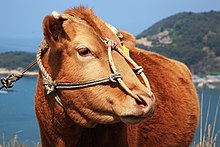 | |
| Conservation status | FAO (2007): not at risk |
|---|---|
| Other names |
|
| Country of origin | Korea |
| Use | meat |
| Traits | |
| Weight |
|
| Height |
|
| Coat | brown |
| Horn status | horned in both sexes |
| Notes | |
| Bos taurus | |
| |
| Hanwoo | |
| Hangul | 한우 |
|---|---|
| Hanja | 韓牛 |
| Revised Romanization | Hanu |
| McCune–Reischauer | Hanu |
The Hanwoo (Korean: 한우), also Hanu or Korean Native, is a breed of small cattle native to Korea. It was formerly used as a working animal, but is now raised mainly for meat. It is one of four indigenous Korean breeds, the others being the Chikso [ko], the Heugu [ko] and the Jeju Black.
History
The Hanwoo was traditionally a working animal breed. Until the expansion of the South Korean economy in the 1960s, it was little used for beef production. A herd book was established in 1968. Hanwoo beef has since become a premium product.
The Hanwoo was listed by the FAO as "not at risk" in 2007. In 2003, the total population was reported to be about 1 240 000; in 2014, it was reported as 2 670 000.
In 2001, the Hanwoo was suggested to be a hybrid between taurine and indicine cattle. A mitochondrial DNA study in 2010 found it to be closely related to two taurine breeds, the Holstein and the Japanese Black, and distinctly different from the indicine Nelore and Zwergzebu [de]. In 2014, single-nucleotide polymorphism analysis found Korean cattle to form a distinct group with the Yanbian breed of China, separate from European taurine breeds and distant from the indicine group.
Characteristics
The Hanwoo is a small breed. The coat is brown; both sexes are horned. Cows have good maternal qualities, but milk production is low, little more than 400 L in a lactation of 170 days. The cattle are fed rice straw as their principal source of roughage. A rare white variant of the Hanwoo has been bred since 2009; in 2014 there were 14 head. It is reported to DAD-IS as a separate breed.
Use
Despite its high price, Hanwoo beef is preferred in Korean cuisine, as it is typically fresher and of better quality than cheaper imported substitutes. Kim et al. (2001) noted, "Hanwoo is regarded as a premium beef because of its high palatability and desired chewiness". Since Koreans consider Hanwoo beef a cultural icon and one of the top-quality beefs of the world, it is used in traditional foods, popular holiday dishes, or as a special-day gift. Hoengseong County is best known for its Hanwoo cattle, where the environment is well-suited for cattle farming. The county began a strategic marketing campaign to brand itself as the origin of the highest quality beef in Korea; selling meat as a "premium product".
Gallery
References
- ^ Breed data sheet: Hanwoo/Korea, Republic of. Domestic Animal Diversity Information System of the Food and Agriculture Organization of the United Nations. Accessed January 2017.
- ^ Valerie Porter, Lawrence Alderson, Stephen J.G. Hall, D. Phillip Sponenberg (2016). Mason's World Encyclopedia of Livestock Breeds and Breeding (sixth edition). Wallingford: CABI. ISBN 9781780647944.
- Breeds reported by Korea, Republic of. Domestic Animal Diversity Information System of the Food and Agriculture Organization of the United Nations. Accessed January 2017.
- Barbara Rischkowsky, D. Pilling (eds.) (2007). List of breeds documented in the Global Databank for Animal Genetic Resources, annex to The State of the World's Animal Genetic Resources for Food and Agriculture. Rome: Food and Agriculture Organization of the United Nations. ISBN 9789251057629. Accessed January 2017.
- ^ Sun Jin Hur; Gu Boo Park; Seon Tea Joo (June 2008). "A Comparison of the Meat Qualities from the Hanwoo (Korean Native Cattle) and Holstein Steer". Food and Bioprocess Technology. 1 (2): 196–200. doi:10.1007/s11947-008-0061-2. S2CID 95534385.
- EunHee Kim, Hyun Sub Cheong, Joon Seol Bae, Ji-Yong Chun, Tae Joon Park, KyoungKap Lee, YoungMin Yun, Hyoung Doo Shin (2010). Identification of genetic polymorphisms in bovine mtDNA Archived 2017-01-11 at the Wayback Machine. Journal of Animal Science 88 (8):2551-2555. doi:10.2527/jas.2009-2235
- Seung-Hwan Lee, Byoung-Ho Park, Aditi Sharma, Chang-Gwon Dang, Seung-Soo Lee, Tae-Jeong Choi, Yeon-Ho Choy, Hyeong-Cheol Kim, Ki-Jun Jeon, Si-Dong Kim, Seong-Heum Yeon, Soo-Bong Park, Hee-Seol Kang (2014). Hanwoo cattle: origin, domestication, breeding strategies and genomic selection. Journal of Animal Science and Technology 56 (2). doi:10.1186/2055-0391-56-2
- Breed data sheet: Hanwoo White/Korea, Republic of. Domestic Animal Diversity Information System of the Food and Agriculture Organization of the United Nations. Accessed January 2017.
- B.C. Kim; M.S. Rhee; Y.C. Ryu; J.Y. Imm; K.C. Koh (December 2001). "Early postmortem processing conditions on meat quality of Hanwoo (Korean Native Cattle) beef during storage". Asian-Australasian Journal of Animal Sciences. 14 (12): 1763–1768. doi:10.5713/ajas.2001.1763.
- "Fall colors and fine food await in rural county". Korea JoongAng Daily. 2015-10-03. Archived from the original on 2016-08-04. Retrieved 2016-06-27.
- "Hanwoo Beef Goes Premium". The Korea Times. 2008-08-13. Retrieved 2016-06-27.
Further reading
- Deepening about Hanwoo Archived 2024-01-14 at the Wayback Machine
![]() Media related to Hanu at Wikimedia Commons
Media related to Hanu at Wikimedia Commons


